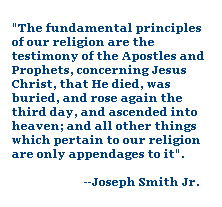Monetary System
Religion depends on an equitable government to protect it as well as an equitable economic system to provide equal opportunity to its members. Religious charity is only required to address temporal shortcomings and inequalities that arise. But the correct sysyen can minimize this need, in spite of the poor always being with us. God promises that among His people in Zion, there would be no poor.
The equation that describes how money works is the Milton Friedman monetarist equation:
M x V = P x G (money supply) x (velocity) = (inflation) x (growth)
Too much money supply or velocity will be inflationary. Not enough will limit economic growth. The perfect money supply would create money at the exact time it was needed (just-in-time), and for real things only. Most money has always been virtually created and generated at the time of loan origination. The problem has always been that when money is created, that it needs to have backing, but to base it on gold and silver only, has always been a problem because there is never enough of it by themselves. The ideal money system will prevent inflation at the same time as being full-reserve which will protect banks.
Safety Society System:
1. Majority of money is created by Congress/US Treasury at loan origination.
2. Simple federal interest rate (prime) controls inflation by making money more or less expensive to barrow vs. saving. Should always been more expensive to purchase something with borrowed money than with savings.
3. Federal government earns prime interest (fee) on nearly 100% of money creation and can then repeal the federal income tax.
4. Local Safety Society System Banks are full reserve and are non-profit and handle loan origination and charge a loan origination fee at time of loan origination. Fees cover overhead/salaries of the bank. 100% of deposited money (mostly virtual) is held by the bank and not re-invested or re-loaned. New money is created, on-demand, by the US Treasury.
5. Loans are granted to individuals or groups based on the projected value of the land, home, minerals, and other real items that are to be purchased, built, mined, and/or produced.
6. Barrowers build equity from their first repayment.
7. Missed payments and depreciation are deducted from borrowers equity. This constitutes a built-in mortgage insurance. Default does not occur until all borrower equity is lost.
8. Loan Default results in bank repossessing home, land, building, factory, mine, (real property), etc. which it can then resell to recoup lost funds.
9. Money is not only based on gold, and silver, but also land, houses, mines, the projected value of the minerals in the mine, and any other real property that possesses long-term intrinsic value which could also apply to certain machinery, and heirloom goods.
10. Money would never be created and loaned in this system to purchase stock or derivatives (paper).
11. SSS is free of speculation. Venture capitalist are free to speculate and invest, (win and lose) as the wish, but their loses can never be bailed out by the government.
12. Money supply (M) always keeps pace with economic need and economic growth (G).













